The GDPR, short for General Data Protection Regulation, is a European Union law that protects users’ privacy when using websites.
We’ve received dozens of emails from users asking us to explain the GDPR in plain English and share tips on how to make your WordPress site GDPR-compliant.
In this article, we will explain everything you need to know about the GDPR and WordPress (without the complex legal stuff).
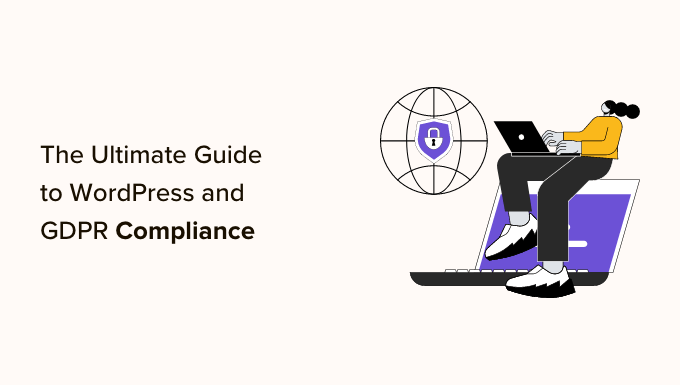
Disclaimer
We are not lawyers, and nothing on this website should be considered legal advice.
To help you easily navigate through our ultimate guide to WordPress and GDPR compliance, we have created a table of contents below:
- What Is the GDPR?
- Does the GDPR Apply to My WordPress Website?
- What Is Required of Website Owners Under the GDPR?
- Is WordPress GDPR Compliant?
- Additional Areas on Your Website to Check for GDPR Compliance
- Best WordPress Plugins for GDPR Compliance
- Final Thoughts
- Expert Guides on Making Your WordPress Site GDPR-Compliant
- Additional Resources
What Is the GDPR?
The General Data Protection Regulation (GDPR) is a European Union (EU) law that took effect on May 25, 2018. The goal of the GDPR is to give EU citizens control over their personal data and change the data privacy approach of organizations across the world.
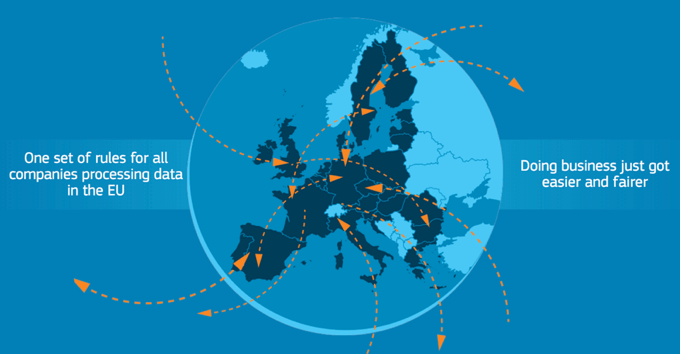
Over the years, you’ve likely gotten dozens of emails from companies like Google about the GDPR, their new privacy policies, and a bunch of other legal stuff. That’s because the EU has made big penalties for people who don’t comply with the regulations.
Businesses that are not in compliance with the GDPR’s requirements can face large fines of up to 4% of a company’s annual global revenue or €20 million (whichever is greater). This is enough reason to cause widespread panic among businesses around the world.
What Is the CCPA?
The state of California introduced similar privacy legislation on January 1, 2020, though the potential fines are much lower.
The California Consumer Privacy Act (CCPA) is designed to protect the personal information of Californian residents. It gives them the right to know what personal information is being collected about them, request its deletion, and opt out of the sale of their data.
In this article, we will focus on the GDPR, but many of the steps we list in this article will also help you become CCPA compliant.
This brings us to the big question that you might be thinking about:
Does the GDPR Apply to My WordPress Website?
The answer is YES. It applies to every business, large and small, around the world (not just in the European Union).
If your WordPress website has visitors from European Union countries, then this law applies to you.
But don’t panic. It’s not the end of the world.
While the GDPR can escalate to those high levels of fines, it will start with a warning, then a reprimand, and then a suspension of data processing.
And only if you continue to violate the law will the large fines hit.
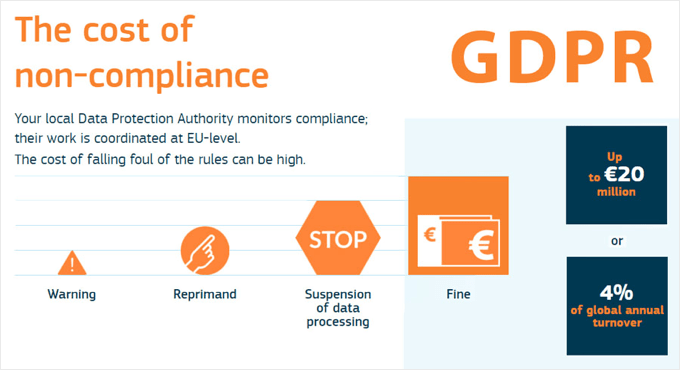
The EU isn’t some evil government out to get you. Its goal is to protect innocent consumers from reckless data handling that could result in a breach of their privacy.
In our opinion, the maximum fine is largely intended to get the attention of large companies like Facebook and Google so that this regulation is NOT ignored. Furthermore, this encourages companies to actually put more emphasis on protecting people’s rights.
Once you understand what is required by the GDPR and the spirit of the law, then you will realize that none of this is too crazy.
We will also share tools and tips to make your WordPress site GDPR-compliant.
What Is Required of Website Owners Under the GDPR?
The goal of GDPR is to protect users’ personally identifying information (PII) and hold businesses to a higher standard when it comes to how they collect, store, and use this data.
This personal data includes your users’ names, email addresses, physical addresses, IP addresses, health information, income, and more.
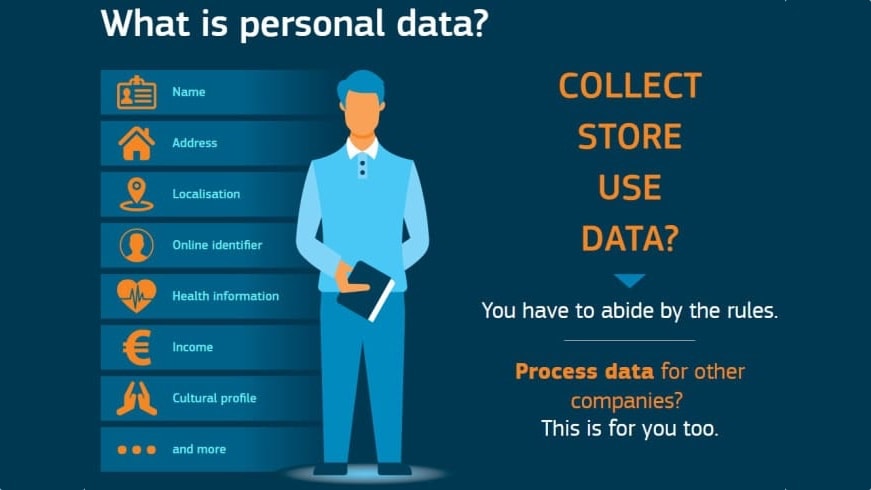
While the GDPR regulation is 200 pages long, here are the most important pillars that you need to know:
You Must Gain Explicit Consent to Collect Personal Information
If you are collecting personal data from an EU resident, you must obtain explicit, specific, and unambiguous consent or permission.
In other words, you can’t just send unsolicited emails to someone who gave you their business card or filled out your website contact form. This is spam. Instead, you must allow them to opt-in to your marketing newsletter.
For it to be considered explicit consent, you must require a positive opt-in. The checkbox must not be ticked by default, must contain clear wording (no legalese), and must be separate from other terms and conditions.
Your Users Have a Right to Their Personal Data
You must inform individuals where, why, and how their data is processed and stored.
An individual has the right to download their personal data and the right to be forgotten.
This means they have a right to demand that you delete their personal data. When a user clicks an unsubscribe link or asks you to delete their profile, you actually need to do that.
You Must Provide Prompt Data Breach Notifications
Organizations must report certain types of data breaches to relevant authorities within 72 hours unless the breach is considered harmless and poses no risk to individual data.
However, if a breach is high-risk, then the company must also inform individuals who are impacted right away.
This will hopefully prevent cover-ups like Yahoo that were not revealed until the acquisition.
You May Need to Appoint a Data Protection Officer
If you are a public company or process large amounts of personal information, then you must appoint a data protection officer.
This is not required for small businesses. Consult an attorney if you are in doubt.
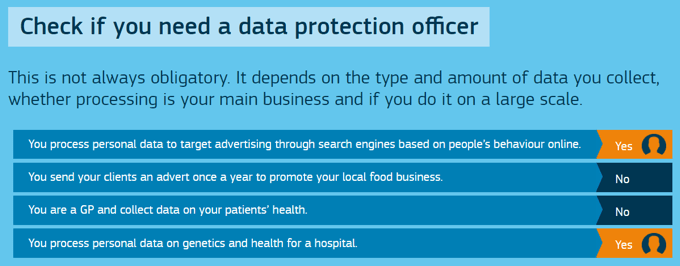
Plain English Summary of What’s Required
To put it in plain English, the GDPR ensures that businesses can’t spam people by sending them emails they didn’t ask for. Businesses also can’t sell people’s data without their explicit consent.
Businesses have to delete users’ accounts and unsubscribe them from email lists when asked. Businesses also have to report data breaches and overall be better about data protection.
Sounds pretty good, at least in theory.
But you are probably wondering what you need to do to make sure that your WordPress site is GDPR-compliant.
Well, that really depends on your specific website (more on this later).
Let us start by answering the biggest question that we’ve gotten from users:
Is WordPress GDPR Compliant?
Yes, the WordPress core software has been GDPR-compliant since WordPress 4.9.6, which was released on May 17, 2018. Several GDPR enhancements were added to achieve this.
It’s important to note that when we talk about WordPress, we are talking about self-hosted WordPress.org. This is different from WordPress.com, and you can learn the difference in our guide on WordPress.com vs. WordPress.org.
Having said that, due to the dynamic nature of websites, no single platform, plugin, or solution can offer 100% GDPR compliance. The GDPR compliance process will vary based on the type of website you have, what data you store, and how you process data on your site.
Ok, so you might be thinking, what does this mean in plain English?
Well, by default, WordPress comes with the following GDPR enhancement tools:
Comments Consent Checkbox
Before May 2018, WordPress would store the commenter’s name, email, and website as a cookie on the user’s browser by default. This made it easier for users to leave comments on their favorite blogs because those fields were pre-filled.
Due to the GDPR’s consent requirement, WordPress has added a consent checkbox to the comment form.

The user can leave a comment without checking this box. However, they will have to manually enter their name, email, and website every time they do so.
Tip: Make sure that you are logged out when testing to see if the checkbox is there.
If the checkbox is still not showing, then your theme is likely overriding the default WordPress comment form. Here’s a step-by-step guide on how to add a GDPR comment privacy checkbox in your WordPress theme.
Personal Data Export and Erase Features
WordPress offers site owners the tools they need to comply with the GDPR’s data handling requirements and honor users’ requests for exporting personal data as well as removal of users’ personal data.
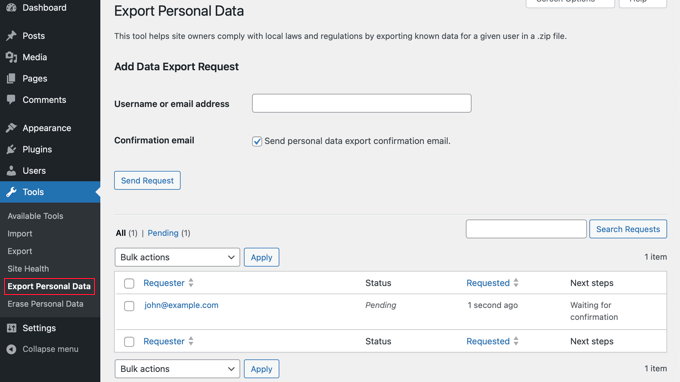
The data handling features can be found under the Tools menu inside WordPress admin. From here, you can go to Export Personal Data or Erase Personal Data.
Privacy Policy Generator
WordPress comes with a built-in privacy policy generator. It has a pre-made privacy policy template and offers you guidance on what else to add. This helps you be more transparent with users in terms of what data you store and how you handle their data.
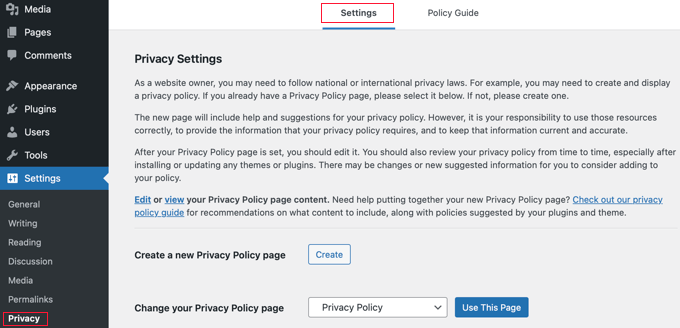
You can learn more in our guide on how to create a privacy policy in WordPress.
These three features are enough to make a default WordPress blog GDPR-compliant. However, your website will likely have additional areas that will also need to be in compliance.
Additional Areas on Your Website to Check for GDPR Compliance
As a website owner, you might be using various WordPress plugins that store or process data, and these can affect your GDPR compliance. Common examples include:
Depending on which WordPress plugins you are using on your website, you will need to act accordingly to make sure that your website is GDPR compliant.
A lot of the best WordPress plugins have added GDPR enhancement features. Let’s take a look at some of the common areas that you will need to address.
Google Analytics
Like most website owners, you are likely using Google Analytics to get website stats. This means that you might be collecting or tracking personal data like IP addresses, user IDs, cookies, and other data for behavior profiling.
To be GDPR compliant, you need to do one of the following:
- Anonymize the data before storage and processing begins.
- Add an overlay that gives notice of cookies and asks users for consent prior to tracking.
Both of these are fairly difficult to do if you are just pasting Google Analytics code manually on your site. However, if you are using MonsterInsights, the most popular Google Analytics plugin for WordPress, then you are in luck.
They have released an EU compliance addon that helps automate the above process.

MonsterInsights also has a very good blog post talking about about the GDPR and Google Analytics. This is a must-read if you are using Google Analytics on your site.
Contact Forms
If you are using a contact form in WordPress, then you may need to add extra transparency measures. This is especially true if you are storing the form entries or using the data for marketing purposes.
Here are some things to consider when making your WordPress forms GDPR-compliant:
- Get explicit consent from users to store their information.
- Get explicit consent from users if you are planning to use their data for marketing purposes, such as adding them to your email list.
- Disable cookies, user-agent, and IP tracking for forms.
- Comply with data deletion requests.
- If you are using a SaaS form solution, make sure you have a data processing agreement with your form providers.
The good news is that you don’t need to organize a data processing agreement if you are using a WordPress plugin like WPForms, Gravity Forms, or Ninja Forms.
These plugins store your form entries in your WordPress database, so to stay GDPR compliant, you just need to add a consent checkbox with a clear explanation.
WPForms, the contact form plugin we use on WPBeginner, has several GDPR enhancements to make it easy for you to add a GDPR consent field, disable user cookies, disable user IP collection, and disable entries with a single click.
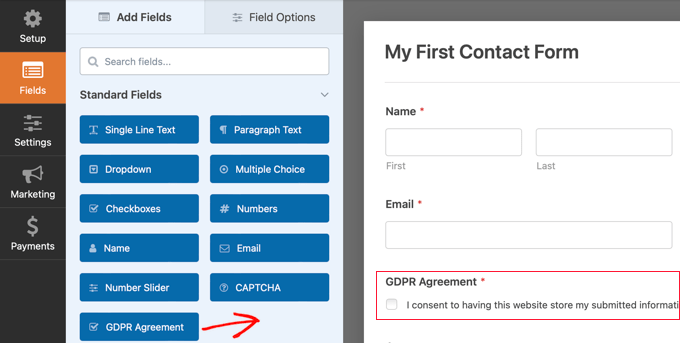
You can see our step-by-step guide on how to create GDPR-compliant forms in WordPress.
Email Marketing Opt-in Forms
Similar to contact forms, if you have any email marketing opt-in forms like popups, floating bars, inline forms, and others, then you need to make sure that you get explicit consent from users before adding them to your list.
This can be done by either:
- Add a checkbox that the user has to click before opt-in.
- Simply require double-optin to your email list.
Top lead-generation solutions like OptinMonster have added GDPR consent checkboxes and other necessary features to help you make your email opt-in forms compliant.
You can read more about GDPR strategies for marketers on the OptinMonster blog.
eCommerce and WooCommerce Stores
If you are using WooCommerce, the most popular eCommerce plugin for WordPress, then you need to make sure your website is in compliance with the GDPR.
Luckily, the MonsterInsights team has prepared an in-depth guide on how to make a WooCommerce store GDPR compliant.
Retargeting Ads
If your website is running retargeting pixels or retargeting ads, then you will need to get the user’s consent.
You can do this by using a plugin like WPConsent. It blocks all tracking scripts until users give their permission, unlike basic cookie notices that just display a warning.
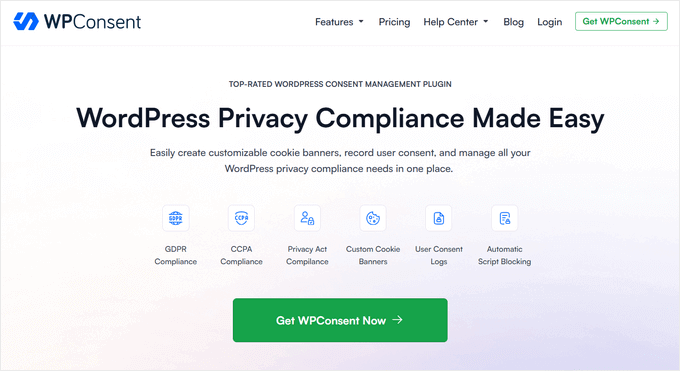
The plugin handles popular services like Google Analytics and Facebook Pixel while keeping detailed consent records, so you can run your marketing campaigns knowing you’re fully compliant.
You can find detailed instructions in our guide on how to add a cookies popup in WordPress for GDPR/CCPA.
Google Fonts
Google Fonts are a great way to customize the typography on your WordPress website.
However, Google Fonts has been found to violate GDPR regulations. That’s because Google logs your visitor’s IP address each time a font is loaded.
Luckily, there are a few ways to handle this so your website is GDPR-compliant. For example, you can load your fonts locally, replace Google Fonts with another option, or disable them.
You can learn how in our guide on how to make Google Fonts privacy-friendly.
Best WordPress Plugins for GDPR Compliance
There are several WordPress plugins that can help you automate some parts of GDPR compliance.
However, no plugin can offer 100% compliance due to the dynamic nature of websites.
Beware of any WordPress plugin that claims to offer 100% GDPR compliance. They likely don’t know what they are talking about, and it’s best for you to avoid them completely.
Below is our list of recommended plugins for GDPR compliance:
- WPConsent automatically blocks all tracking scripts until visitors give permission, keeps detailed records of user consent, and includes easy-to-customize privacy banners to keep your site compliant. There’s also a free version of WPConsent available.
- If you use Google Analytics, then we recommend you use MonsterInsights and enable their EU compliance addon.
- WPForms is the most user-friendly WordPress contact form plugin and offers GDPR fields and other features.
- Cookie Notice is a popular free plugin for adding an EU cookie notice, and it integrates well with top plugins like MonsterInsights and others.
- GDPR Cookie Consent lets you create an alert bar on your site so the user can decide whether to accept or reject cookies and covers CCPA as well as GDPR.
- WP Frontend Delete Account is a free plugin that allows users to automatically delete their profile on your site.
- OptinMonster is advanced lead generation software that offers clever targeting features to boost conversions while being GDPR compliant.
- PushEngage lets you send targeted push messages to visitors after they leave your site and is fully GDPR compliant.
- Smash Balloon gives you a GDPR-compliant way to embed live feeds and show posts from Facebook, Twitter, Instagram, YouTube, TripAdvisor, and more.
- Novashare provides a way to let users share your content on social media without collecting their personal data or placing cookies.
You will find more options in our expert pick of the best WordPress GDPR plugins to improve compliance.
We will continue to monitor the plugin ecosystem to see if any other WordPress plugin stands out and offers substantial GDPR compliance features.
Final Thoughts
The GDPR has been in effect since May 2018.
Perhaps you have had your WordPress website for a while and have been working towards GDPR compliance. Or you may be just starting out with a new website.
Either way, there is no need for panic. Just continue to work towards compliance and get it done ASAP.
You may be concerned about the large fines. Remember that the risk of being fined is minimal. The European Union’s website states that first, you’ll get a warning, then a reprimand, and fines are the last step if you fail to comply and knowingly ignore the law.
Remember that the EU is not out to get you. They are doing this to protect user data and restore people’s trust in online businesses.
As the world goes digital, we need these standards. With the recent data breaches of large companies, it’s important that these standards are adapted globally.
It will be good for all involved. These new rules will help boost consumer confidence and, in turn, help grow your business.
We hope this tutorial helped you learn how to become GDPR-compliant on your WordPress blog. You might also like to see our expert guides on how to make your website GDPR-compliant.
Expert Guides on Making Your WordPress Site GDPR-Compliant
- How to Add a GDPR Comment Privacy Opt-in Checkbox in WordPress
- How to Add a Cookies Popup in WordPress for GDPR/CCPA
- How to Know if Your WordPress Website Uses Cookies
- How to Create GDPR-Compliant Forms in WordPress
- How to Keep Personally Identifiable Info Out of Google Analytics
- How to Make Google Fonts Privacy-Friendly
- How to Disable Google Fonts on Your WordPress Website
- How to Add a Privacy Policy in WordPress
If you liked this article, then please subscribe to our YouTube Channel for WordPress video tutorials. You can also find us on Twitter and Facebook.
Legal Disclaimer
We are not lawyers, and nothing on this website should be considered legal advice. Due to the dynamic nature of websites, no single plugin or platform can offer 100% legal compliance.
When in doubt, it’s best to consult a specialist internet law attorney to determine if you are in compliance with all applicable laws for your jurisdictions and your use cases.
Additional Resources
- GDPR Hysteria Part I and Part II by Jacques Mattheij
- Data Protection Infographic by the European Commission
- Principles of the GDPR by the European Commission
- GDPR and MonsterInsights – everything you need to know about Google Analytics GDPR compliance
- GDPR Enhancement Features for WPForms – everything you need to know about GDPR compliance for your WordPress forms
- WooCommerce and the GDPR – everything you need to know about GDPR compliance for your online store
- OptinMonster and the GDPR – everything you need to know about GDPR compliance and email marketing opt-in forms
If you liked this article, then please subscribe to our YouTube Channel for WordPress video tutorials. You can also find us on Twitter and Facebook.





Olaf
GDPR is truly a complex topic, sometimes so intricate that for corporate websites, it’s really better to hire a professional or a lawyer for it. It’s great that you address such a complicated and extensive topic. Although I’ve taken several courses to gain the knowledge to build a GDPR-friendly website, there’s always some new information I’m happy to learn.
Chris
I never paid attention to those tabs under the tools tab in Admin until now. The privacy policy page that WordPress provides seems enough for any website I might run in the future. Is the GDPR only applicable to websites domicile in the EU, or does it apply to websites that have visitors from the EU?
WPBeginner Support
It would affect your site if you have visitors from the EU
Admin
Jiří Vaněk
GDPR applies to all users who are citizens and permanent residents of countries within the European Union. This means that if there’s a possibility such users might visit your site, it should be GDPR-compliant and provide the same safeguards. For example, your website should have a cookie consent banner allowing users to refuse cookies, and email address collection should use double opt-in verification, among other measures.
Whether legal enforcement would occur if you are a citizen of a non-EU country is questionable and likely complicated. Personally, I would focus on ensuring compliance for sites primarily targeting EU citizens. For a personal blog of someone living in the USA, GDPR might not be as critical since it is the user’s choice to visit such sites. However, it’s an interesting but complex issue. Nonetheless, it never hurts to comply with GDPR rules.
Mrteesurez
Also, I can see maybe that’s why WordPress itself comes with a basic privacy policy generator with some suggested text.
I just discovered it not so long.
But is that basic content sufficient ?? because sometimes I used the basic WP generated policy contents for new blogs.
WPBeginner Support
You would want to edit the content in the privacy policy to suit your needs and if you are concerned then you would want to check with a legal professional.
Admin
Mrteesurez
OK, maybe when the blog grows and gaining more traction, then, I can seek out to legal professional for a standard and official policy.
Thanks.
Mrteesurez
Honestly, most of the bloggers and online marketer who just want to make money online don’t usually take this serious.
I could remember how much fine I heard in the press that Google have paid and some other businesses that use tracking software.
My question is, Is this only applicable for if I have visitors from EU ??
Also, you talk of ‘checkbox’.
In WPbeginner, checkbox is not showing, I manually need to re-enter names and email every time I want to comment. Can you fix this ?? or is there any reason no to do this ??
WPBeginner Support
It is applicable to more than the EU, we give an example with California in the article above.
We do not have the consent checkbox at the moment, our theme style overrides the checkbox. We do not save your information in the browser for the time being.
Admin
Mrteesurez
Ok, I understand but you can try to implement it for easy participation in the community.
It can be autofilled or save it in browser but give disclaimer or include it in your privacy policy.
Jiří Vaněk
I hadn’t paid much attention to this topic before, but practice eventually showed me that it’s indeed much better to have everything in order on the website, especially when it comes to laws. Living in an EU country, GDPR is now a top priority for me. Guides like these are great because there’s always something one might overlook.
WPBeginner Support
Glad you found our guide helpful
Admin
Moinuddin Waheed
Thankfully I am not from any of the European country which means GDPR rule will not apply to my website. But data protection has been a prime topic for every country not that for European countries only. we have similar data protection bill in our country as well. it is infact good to see that there is enhanced awareness in terms of data and content online.
thanks for detailing every bit of GDPR for us
WPBeginner Support
You’re welcome
Admin
Ralph
Good to find such a detailed guide that not only explains what to do, but also how and why it is important.
I see GDPR as a plus for user as he can have some impact on his data, but we have to have more and more annoying popups on websites. Cookies, ads, newsletters, GDPR… In 5 or 10 years we will spend more time closing this than reading websites. I wish governments can come up with new 1 idea, that will replace all of that.
Geethu
Thank you for the detailed explanation. It cleared some of the queries I had especially if GDPR applied to websites outside the EU and what to keep in mind while making them GDPR complaint.
WPBeginner Support
You’re welcome, glad we could clear up some confusion!
Admin
Ram E.
Thanks for listing the two cookie notice plugins (Cookie Notice and GDPR Cookie Consent)! I’ve been meaning to find and install one on my blog. This compliance stuff is one of the reasons why I haven’t opened my blog for user registrations yet, and it’s going to be more complicated if more and more countries require it. Personally, I think this is not a big deal though if an EU country or California is not one of your top 10 locations by sessions.
WPBeginner Support
You’re welcome, glad our recommendations were helpful
Admin
John Fernandez
Thanks for the article! This guide will help me manage my wordpress site better.
WPBeginner Support
Glad our guide was helpful
Admin
Ahmed Omar
Thank you for the detailed post.
I have concern about GDPR , what if the visitor did not accept the terms, would he still be able to browse my site or register
Thank you
WPBeginner Support
Unless you set it up to prevent access, the users should still be able to browse your site. For registration you can have a required checkbox to prevent registrations.
Admin
Mikolaj
Thanks for the article! It’s good to know that WP tracks the development of the situation on an ongoing basis
Charles Anderson
Great post, helpful WordPress and GDPR guide ness. keep posting more articles.
WPBeginner Support
Thank you, glad you liked our article
Admin
Chris H
A kind of good post. All SMEs and large business should be GDPR compliant. GDPR Awareness must be given to the staffs.
WPBeginner Support
Glad you liked our content
Admin
Shashank
Nice Blog. Thank you for the article about GDPR. Much needed for me
Gavin
I am still a little confused with all this. Some say as long as you get consent and use something like a cookie/privacy popup to alert users and get consent etc its fine. But surely once someone has visited your site the cookies have already been placed in their browser so in this case should all cookies etc not be used until the users agrees? If this is the case how do we achieve this?
Konrad
Some cookies are just required to load the page.
Users consent to the use of 3rd party and non-essential cookies.
Trond
Hi,
I would just like to add that the Cookie Notice for GDPR plugin states it’s “100% GDPR compliant”. See “features include” at their plugin page.
You say that “Beware of any WordPress plugin that claims to offer 100% GDPR compliance. They likely don’t know what they’re talking about, and it’s best for you to avoid them completely.”
So, how can Cookie Notice be recommended by you?
WPBeginner Support
Hi Trond,
Cookie Notice is a useful plugin, however the plugin alone cannot make your website 100% GDPR compliant.
Admin
Rick OD
how could a law in the European Union hold any water in the USA and how on earth could they fine you or force you to make changes to your website here in the US if no US law forces GDPA compliance?
Mathukutty P. V.
I have Monsterinsights free version. Can not afford to buy pro now so cant install addon.
I was using Jetpack comment, after reading this post changed to wp default. Thanks.
Mathukutty P. V.
Thanks for the clarification. Mine is a personal blog. Will try to modify privacy policy.
Debbie
Excellent article. Could you clarify something I’d not seen mentioned anywhere else?
According to GDPR Article 83, (this is not a quote, but my own summary) fines, penalties, or other consequences for non-compliance, would be based on your footprint as an organization, the degree to which you collect and process data from Europe, and the severity of the infraction.
You said: “While GDPR has the potential to escalate to those high level of fines, it will start with a warning, then a reprimand, then a suspension of data processing, and if you continue to violate the law, then the large fines will hit.” And then you have an infographic with this info.
That’s a very specific progression. Can you point to an official notification or article somewhere where this is stated? Specifically, that an infraction would start with a warning, etc. And let’s just assume we’re talking about the average or smaller site and not Facebook. Thanks!
Thanks!